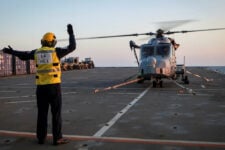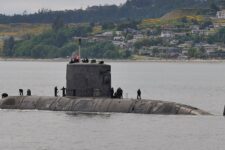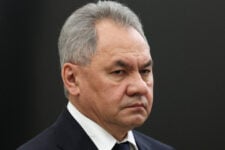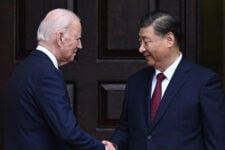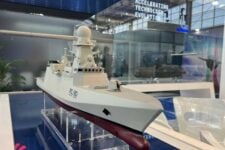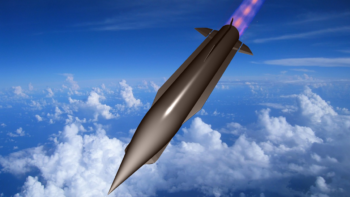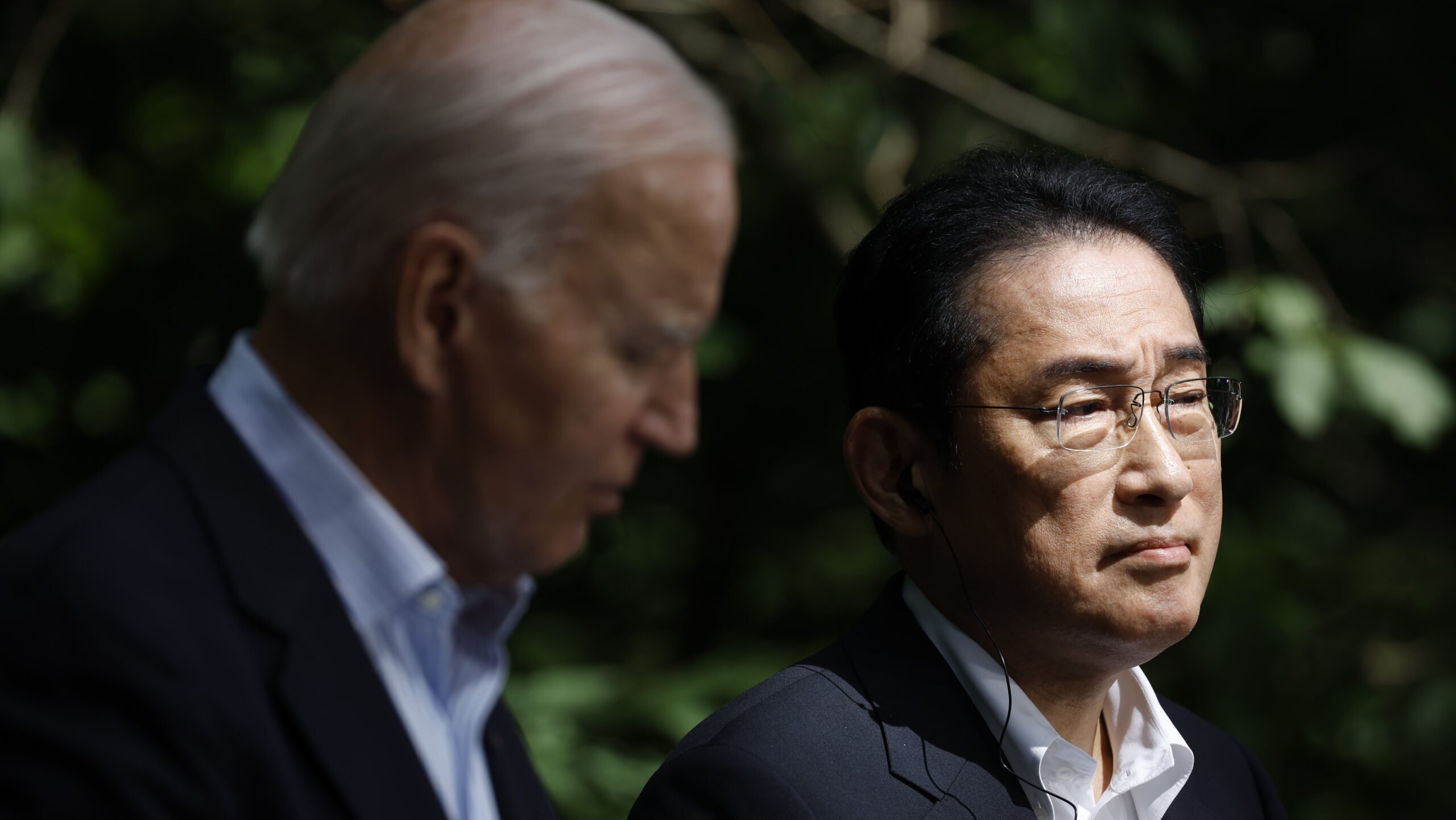
Fumio Kishida, Japan’s prime minister, and US President Joe Biden, left, at a news conference during a trilateral summit at Camp David on Friday, Aug. 18, 2023. Photographer: Ting Shen/Bloomberg via Getty Images
SYDNEY — Japanese Prime Minister Fumio Kishida’s visit to Washington this week, including the first Congressional address by a Japanese prime minister in nine years, will be a chance to express Tokyo’s dedication to increasing its defensive posture in the region.
But, analysts say, just as important as the bilateral relationship building that can occur this week will be the potential growth of a trilateral relationship between the US, Japan and the Philippines, thanks to overlap with a visit by Philippine President Ferdinand Marcos Jr. to the District of Columbia. The two regional leaders will have a trilateral meeting with US President Joe Biden.
“Japan is basically signaling both to the Philippines and the US, and beyond that, [to] Southeast Asia and others in the region, that they should look to Japan as a leader in this space,” John Blaxland, head of the Australian National University’s office in Washington, told Breaking Defense. “That’s really pretty groundbreaking.”
The signals in the leadup to the Biden meeting have been clear: Tokyo is looking to expand its defense capabilities and presence, thanks both to the ongoing threat from North Korea and China’s aggressiveness in the region.
According to the AP, Biden and Kishida are “expected to agree to start discussions on establishing a unified command on each side, seen as a major structural change to enhance interoperability and response capability. They are also expected to agree on a plan to establish a new framework for weapons co-development, and to allow repair and maintenance of U.S. warships in Japan to support their operation in the Western Pacific.”
“Defense industry cooperation between Japan and the United States, as well as with like-minded countries, are extremely important,” Kishida was quoted by the AP as telling foreign media in a Friday interview.
It is also expected there will be movement, albeit likely tentative, towards Japan’s inclusion in the AUKUS security agreement. The FT on Sunday reported there will be a statement from the AUKUS defense ministers towards expansion of Pillar II, and last week US Deputy Secretary of State Kurt Campbell said the visit will “largely be historic for the updating of the US Japan security partnership.”
Japan has been trying to raise its profile for some time, according to Collin Koh, senior fellow at Singapore’s Nanyang Technological University.
RELATED: Philippines, Japan near long-range missile milestones as they arm up for China
“Japan has been stepping up in Southeast Asia, even during Trump’s term when it [the US] was viewed as being less invested in SE Asia, Back then, [Japanese Prime Minister Shinzo] Abe visited Manila and it was viewed as Japan stepping up to help fill the US void. While Japan is clearly trying to equalize its alliance with the US, it’s going ahead to carve out its own strategic niche in SE Asia,” he wrote in an email.
Showing an interest in defense spending is also a bit of a self-preservation technique, noted Blaxland.
“There’s been some wariness about what the United States might do after the elections in November,” should former president Donald Trump win, Blaxland said. “I think Japan is also telegraphing to a potential Trump administration that they are doing their best … They are prepared to put their shoulder to the wheel to carry more of the burden, which Trump Mark One was big on emphasizing.”
Philippine Relations
One doesn’t have to look hard to find an example of the growing relations between the US, Philippines and Japan.
On April 7, the three nations, joined by Australia, sailed and flew together in the South China Sea where China has repeatedly threatened and confronted Philippine vessels operating within that country’s Exclusive Economic Zone. Japan provided a destroyer, the JS Akebono, that engaged in anti-submarine warfare training, according to a statement by the Japanese embassy in Manila.
The message was made absolutely clear by Japan’s Minister of Defense Kihara Minoru. He said in the statement “that the issue concerning the South China Sea is directly related to the peace and stability of the region and a legitimate concern of the international community and expressed Japan’s opposition towards any unilateral attempts to change the status quo by force in the region.”
China claims much of the region, and has been especially aggressive around the Second Thomas Shoal, where the Philippines grounded an old boat to help bolster its legal claim. For its part China has illegally claimed sovereignty over a number of areas where its has destroyed some of the last remaining pristine reefs to build military bases in hopes it can establish de facto claims.
Media reports from Washington indicate Japan, the US and Filipino militaries may decide during this week’s trilateral meetings to make regular transits of the South China Sea. Talks about such patrols have been underway since June last year.
As a sign of the growing interest from Tokyo for increased ties with Manila, Japan’s first use of its new Official Security Assistance policy, which allows providing partners with military equipment, was for four air defense radars to the Philippines last year. Also in 2023, the two nations started negotiating a reciprocal access agreement (RAA) that is expected to improve maritime cooperation and allow Japanese and Philippine forces to train together in each country.
A report by the Center for Strategic and International Security in Washington argues that Japan should go even further.
“The Marcos government’s decisions to stand up to Chinese coercion in the South China Sea and rebuild the U.S. alliance represent a significant strategic opportunity for Washington and Tokyo, who should do everything possible to reinforce and support Manila’s actions. Including Manila in minilateral engagement should continue to be a high priority, and the United States and Japan should coordinate closely in providing security assistance, to avoid duplication and ensure interoperability. Tokyo should prioritize concluding a Reciprocal Access Agreement with Manila,” the report says.
How Will China React?
While the summit on paper is just about the countries involved, like everything in the region, it comes with a clear focus on China — which raises the question of how Beijing will react.
“The standard official response is to warn the Philippines and third countries [referring to Japan and the US] not to undertake moves that undermine the security of other regional states,” by which Beijing is actually referring to only itself, offers Koh. He said in an email that China has “little leverage to disrupt the trilateral – even with the Philippines supposedly being the weakest of the three parties.”
After months of harsh threats, ramming Philippine vessels and, most recently, injuring four Filipinos when Chinese Coast Guard ships aimed a water cannon at a Philippine vessel, “Beijing might also have realized how limited its options are” Koh wrote. “So from the policy perspective, we are likely to see Beijing fume and watch how the trilateral unfold, perhaps hoping that the initiative won’t go too far and even fizzle out like foam in the ocean waves (the way Wang Yi once described the QUAD). And it might wait and see whether there are gaps in this trilateral for it to exploit to try to create possible rifts.”
Koh expects China “to keep close tabs on the trilateral military activities, and for that matter, the military moves of each of the three partners.”
The Chinese are playing a “cynical” game in the South China Sea, Blaxland said.
“China wants to see the Philippines overreach. It wants to see the United States also overreach and then justify a reaction from China that uses that overreach as an excuse for being belligerent,” he argued. But the current approach of using water cannon and aggressive ship driving makes that less likely.
“So they’re practicing I think, non-kinetic warfare. This unrestricted competition, I like to call it, is in a domain that they know is below the threshold to trigger a kinetic military response. Were the Chinese to sink a Philippine Coast Guard or naval vessel that would probably be a sufficient trigger to invoke the treaty, the US-Filipino defense arrangement. But water cannon are below that threshold. The Filipinos know it and the Americans know it. That’s why it’s so clever and why it’s so cynical,” the Australian said.

